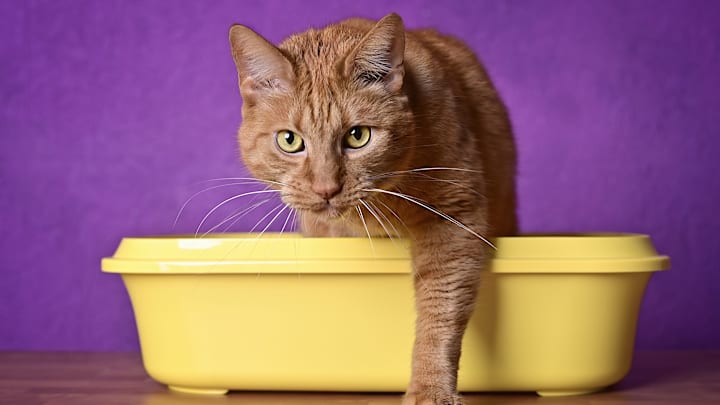Cats are creatures of habit, and frequenting a litter box is an important part of their daily lives that usually involves minimal training. “Cats have a really strong desire to go and dig and bury in a soft, sandy substance,” certified cat trainer Tori Schlosser at Purrusasion Cat Behavior Consulting and Training in Regina, Saskatchewan, tells Mental Floss. Because they’re notoriously neat and clean animals, discovering a pile of poop or a puddle of pee on the floor is often an unpleasant surprise for the humans who take care of them.
It’s a frustrating issue to encounter, but a cat not using its litter box is trying to send you a message. Schlosser encourages pet owners to take their human feelings out of the situation and consider it from the cat’s perspective: It’s their way of communicating that something is not quite right. With trial and error and some detective work, you can help your cat get back to using the litter box.
Check With Your Vet
What you find inside—or, if things aren’t going according to plan, outside—your cat’s litter box is a great indicator of your pet’s health. “When you are scooping, and you are able to see that the pee is clear, there is no blood in the urine, and the poop is a solid good shape,” Schlosser says. “Those are all important things that litter boxes tell us.”

Various illnesses and diseases can cause a cat to stop using its litter box. If your cat has not had previous bathroom issues and abruptly stops using it, take your cat to the vet to rule out any health problems like urinary tract infections, kidney issues, diabetes mellitus, or digestive tract disorders.
It’s also important to consider the age of your cat, as senior cats often have joint and mobility issues. “They might not be able to get up the stairs to where you keep the litter box, or maybe the sides of the box are too high and they can’t get into it anymore,” Schlosser says.
How to Encourage a Cat to Use a Litter Box
Once you’ve ruled out any health issues, there’s some detective work involved in figuring out why your cat won’t use the litter box. One thing to take note of is where they’re going to the bathroom. “If your cat is peeing far from the litter box, it might be territorial. If it’s near the litter box, it’s most likely litter box aversion,” Schlosser says. “They want to do what they are supposed to do, but they just can’t because something in their brain is telling them that it’s not safe.”

Various issues, like a box that’s too small, the wrong type of litter, or a lack of cleanliness could cause litter box aversion. Experiment with various litter box styles to see which suits your cat best. When it comes to size, make sure the box is at least 1.5 times the size of the cat. You could try a different litter (unscented is best) to determine what your animal prefers, or even mix in a litter attractant to encourage your pet to go in the right place.
It’s important to make sure the litter box is clean enough. Aim to scoop any pee and poop at least once a day; some cats may even prefer that their box be cleaned twice a day. You should also use an enzymatic cleaner on the spot where they’ve had an accident, as this will get rid of the scent and hopefully discourage your cat from going on the same spot on the floor.
Cats are sensitive to changes in their environment, and may stop using their litter box when things get out of sorts. Schlosser recommends keeping a journal. “Make a note of when things happen, what has been going on in the house, if there were any changes to routine, or if you had strangers in your house that day,” she says.
If you have more than one cat, Schlosser advises following the “N rule”—the number of cats plus one—when deciding how many litter boxes to have. This is especially important when welcoming new cats to the home. The animals are territorial, which can lead to bathroom issues. Unneutered male cats in particular are known to urinate on walls and furniture to mark their territory. Even single-cat households could benefit from having more than one litter box, as some felines prefer to pee and poop in different places.
Where you put the litter box also matters. “Cats like areas that are socially significant but not super busy. The box should not be in a place with a lot of traffic, but it shouldn’t be shoved in the back of a closet either,” Schlosser says. In other words, don’t try to hide your litter box, no matter how much it may gross you out. If you embrace it, maybe your cat will, too.
